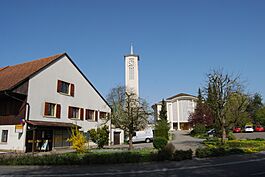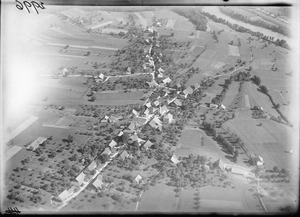Fulenbach facts for kids
Quick facts for kids
Fulenbach
|
||
|---|---|---|

The Catholic church in Fulenbach village
|
||
|
||
| Country | Switzerland | |
| Canton | Solothurn | |
| District | Olten | |
| Area | ||
| • Total | 4.48 km2 (1.73 sq mi) | |
| Elevation | 429 m (1,407 ft) | |
| Population
(Dec 2020 )
|
||
| • Total | 1,772 | |
| • Density | 395.5/km2 (1,024.4/sq mi) | |
| Postal code |
4629
|
|
| Surrounded by | Boningen, Gunzgen, Härkingen, Murgenthal (AG), Neuendorf, Wolfwil | |
Fulenbach is a small town, also called a municipality, located in Switzerland. It's part of the Olten district in the canton of Solothurn. In the local High Alemannic language, its name is Fulebach.
Contents
Discovering Fulenbach's Past
Fulenbach was first mentioned in official records way back in 1226. It was called in villa Vulenbah then. Later, in 1260, its name changed slightly to Fulenbach.
Exploring Fulenbach's Geography
Fulenbach covers an area of about 4.52 square kilometers (1.75 square miles). A large part of this land, almost half, is used for farming. About 29% of the area is covered by forests.
Buildings and roads make up about 17% of the land. Rivers and lakes cover a small portion, about 3.5%. The rest is land that isn't used for farming or building.
Fulenbach is located on a flat area near the Aare river. It includes the main village of Fulenbach. There are also smaller settlements like Stadtacker, Ewigkeit, Färch, and Fulenbacher Bad. Stadtacker grew where an old medieval town, Fridau, once stood before it was destroyed in 1375.
Understanding Fulenbach's Coat of Arms
The coat of arms for Fulenbach has a special design. It is divided into three wavy sections: blue at the top, silver in the middle, and green at the bottom. In the blue section, there is a golden star. This design is called a blazon.
Fulenbach's Population and People
Fulenbach has a population of about 1,700 people. Most people living here speak German. About 93.9% of the population speaks German. Other languages spoken include Albanian and Italian.
Many residents were born in Fulenbach or in the same canton. Others moved here from different parts of Switzerland or from other countries. The population has been growing steadily over the years.
How Fulenbach's Population Has Grown
The chart below shows how the number of people living in Fulenbach has changed over time. You can see how the population has increased from the 1700s to the 2000s.

Fulenbach's Economy and Jobs
In Fulenbach, people work in different types of jobs. These jobs are often grouped into three main sectors:
- Primary sector: This includes jobs related to getting raw materials from nature, like farming or forestry.
- Secondary sector: This involves making things, like in factories (manufacturing) or building homes and roads (construction).
- Tertiary sector: This covers jobs that provide services, such as working in shops, restaurants, transportation, education, or healthcare.
Many people who live in Fulenbach travel to other towns for work. Most people use a private car to get to their jobs, while some use public transportation.
Religion in Fulenbach
Most people in Fulenbach are Roman Catholic. A good number also belong to the Swiss Reformed Church. There are also smaller groups of people who follow other Christian faiths or Islam. Some people do not belong to any church.
Education in Fulenbach
Education is important in Fulenbach. Many adults have finished high school, and some have gone on to college or specialized schools.
The local school system in Solothurn canton starts with two years of non-required Kindergarten. After that, students attend six years of primary school. After primary school, students go to secondary school. Students from Fulenbach attend their lower secondary school in a nearby town.
See also
 In Spanish: Fulenbach para niños
In Spanish: Fulenbach para niños






